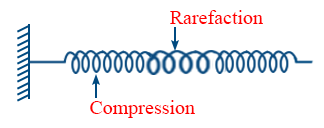Oscillations and Waves
Transverse and longitudinal waves
Transverse wave: A wave in which the particles of the medium vibrate at right angles to the direction of propagation of wave is called a transverse wave.This wave travel in the form of crests and troughs.

Longitudinal wave: A wave in which the particles of the medium vibrate in the same direction in which wave is propagating is called a longitudinal wave.This wave travel in the form of compressions and rare fractions.

Transverse Waves View the Topic in this video From 0:23 To 10:15
Longitudinal Waves View the Topic in this video From 0:20 To 4:54
Disclaimer: Compete.etutor.co may from time to time provide links to third party Internet sites under their respective fair use policy and it may from time to time provide materials from such third parties on this website. These third party sites and any third party materials are provided for viewers convenience and for non-commercial educational purpose only. Compete does not operate or control in any respect any information, products or services available on these third party sites. Compete.etutor.co makes no representations whatsoever concerning the content of these sites and the fact that compete.etutor.co has provided a link to such sites is NOT an endorsement, authorization, sponsorship, or affiliation by compete.etutor.co with respect to such sites, its services, the products displayed, its owners, or its providers.
1. The equation of displacement relation in a progressive wave is given by
y(x, t) = a sin (kx − ωt + Φ)
2. The speed of transverse wave on a stretched string is given by
\tt v = \sqrt{\frac{T}{\mu}}
3. The general formula for speed of longitudinal waves in a medium is
\tt v = \sqrt{\frac{\beta}{\rho}}
4. The speed of longitudinal waves in a solid bar is
\tt v = \sqrt{\frac{Y}{\rho}}
5. The speed of a longitudinal wave in an ideal gas is given by
\tt v = \sqrt{\frac{p}{\rho}}
6. Laplace's correction He pointed out that the pressure variation in the propagation of sound are adiabatic and not isothermal. Thus,
\tt v = \sqrt{\frac{\gamma p}{\rho}}

